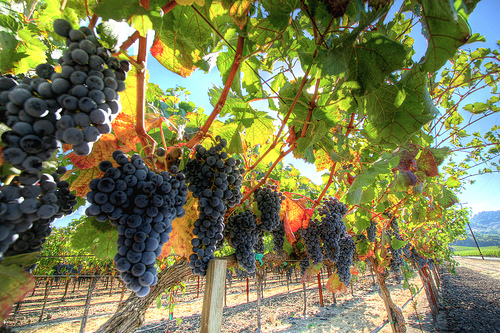Many people in the wine industry are returning to more artisanal and hand crafted forms of winemaking. You don’t need pavilion sized wineries and limitless funds to make great wine – just good taste and some common sense. Amanda Barnes learns a few tricks of the trade to make superb wine the simple way.
For Wine-Republic, February 2013
As you tour around large winery upon large winery you can sometimes become deluded into thinking that winemaking has to be an industrial process. Rows upon rows of enormous tanks end up looking like a fleet of steel robots and the nomadic story of a grape’s journey can sometimes get lost in translation amongst all the machinery.
Making wine is actually a very natural and simple process, so simple that you can in fact do it in your bedroom. Wine fanatic and tour guide Victoria Mermoz started making her own wine in her bedroom two years ago. When a friend was going to throw away some premium samples of grapes from La Rioja, Victoria decided to take them home and see if she could make her own ‘vino’ without any training, fancy machinery or chemicals.
Hand squeezing each grape into a big water bottle, she left them to ferment in their natural yeast. She left the cap off the bottle a bit so that it could get some oxygen, but not too much either, and gently tipped the bottle up and down for a ‘pump over’ twice a day. If the temperature was too hot, she’d put the bottle in her fridge for a while. “I gave it three weeks for fermentation,” she says. “I tasted it everyday to check that it was not too sweet.” When she decided it was ready, she squeezed out the juice using a mesh fabric to separate the skins, put it into bottles to rest, waited a couple months and voila! Perfectly drinkable wine.
Obviously making great wine to sell is not quite as easy as throwing some juice in a Coke bottle, but the grape’s journey in a winery needn’t be obscured by smoke screens either.
A visit to boutique producer Brennan Firth reveals the simple journey of a grape in layman’s terms. He has made wine professionally for ten years in top wineries in Mendoza and the US where he has seen everything from big investment projects to garage wines. Through his experience, he makes his own label Cepas Elegidas (www.cepaselegidas.com.ar) and as well as focusing on sourcing low yield, sustainable grapes, he has in the past used more handcrafted and practical remedies that don’t require complex machinery and overly expensive accessories and instead concentrates on minimal intervention winemaking.
Take for example the year he didn’t have a press available the day he picked, so he found a more creative solution.
“I took a metal picking screen [basically like a large colander] and put it over the picking cart, sanitized some rubber gum boots and started pressing with my feet! I did 8 tons like that. It was super tiring. My winemaking assistant and I took turns jumping up and down, while listening to ACDC. It had to be done over night as the winery needed the screens back in the morning.”
Simple solutions like manually pressing can actually be much more beneficial for the winemaking process, although whether you prefer the vibrations of classical music or Australian hard rock is up to you. Foot pressing (and hand pressing like Victoria did) is much gentler than by machine so you break the tannins less than a machine might, making the final wine softer.
Brennan also had to look for unusual solutions to store his top-up wines one year (which winemakers use to replace wine in barrels that is lost by evaporation). One harvest he had 14 different lots which he wanted to keep separate until ready for the final blend after barrel aging. That would have required separate tanks for each lot. A small stainless steel topping up tank costs around U$1500, so for that harvest it would have required splashing out U$21,000. Instead he used water filter bottles which cost less than U$10, and kept downsizing as the quantities became less to avoid oxidation. More proof that you can find much more affordable solutions if you are ready to put in the extra work.
Plastic bottles also came in handy for cold maceration one year when there wasn’t a temperature-controlled tank available.
“I filled large 2.5 litre coke bottles with water and chucked them in a freezer.” explains Brennan, “Then I put 6 to 8 of them in a tank at a time to bring the temperature down and as the ice inside would melt, I’d swap them around with others from the freezer.”
Temperature regulation can be one of the most expensive aspects in wine making and also one of the least environmentally friendly, but it really needn’t be if you use some common sense and practical thinking. Brennan explained that a simple technique he learnt in wineries in California for increasing the temperature when barrel fermenting is to just bring the barrels outside to the sun all day. A free and natural heat resource that Mendoza rarely lacks.
In larger wineries you’ll see pumps coming in and out of every tank and barrel opening. Simple gravity suction can cut down on pumps, saves a significant amount on electricity bills and is more environmentally friendly.
“The reason why I do gravity suction is to try and use less pumps, because pumping can be hard on wine with lots of oxygen,” says Brennan. “There’s a lot of bacteria in pumps too. I’ve also had experiences where I am racking [syphoning wine into a clean barrel to stabilize and clarify it] when electricity goes out and the pumps stop. You are in the middle of racking and you can’t do anything. Now when the electricity goes out I laugh and put on my head torch and keep pumping with gravity.”
More hand crafted techniques as mentioned above are ideal when you are making boutique production wine in smaller quantities. Visits to Cepas Elegidas and small wineries in Mendoza such as La Azul and Carmelo Patti can reveal the more artisanal, bespoke approach to winemaking. Even bigger wineries are starting to look back to more hand crafted techniques for their top lines, following the global trend towards ‘natural’ or minimum intervention wines. Take for example Trapiche, one of Argentina’s biggest producers, which has started making a premium wine called Manos that is hand harvested and squeezed – not too dissimilar in effect to Victoria’s bedroom wine.
To visit Cepas Elegidas contact Brennan on bfirth@cepaselegidas.com.ar. Victoria is a wine guide for Trout & Wine Tours in Mendoza which also visits Cepas Elegidas.



Great post. I run a winemaking coop of friends in FL, if you can believe that. We operate on a tight budget and love discovering innovative new ways to create wine. I am also a fan of commercial wineries that use rustic methods that produce wines far superior than wineries spending hundreds of thousands of dollars.
Wow – running a coop must keep life interesting! The best things in life are all about innovation, and certainly I believe that wines often taste better (at least in the mind) if you know they are made with more care and personal attention. Best of luck with the coop, I hope you have a great vintage!